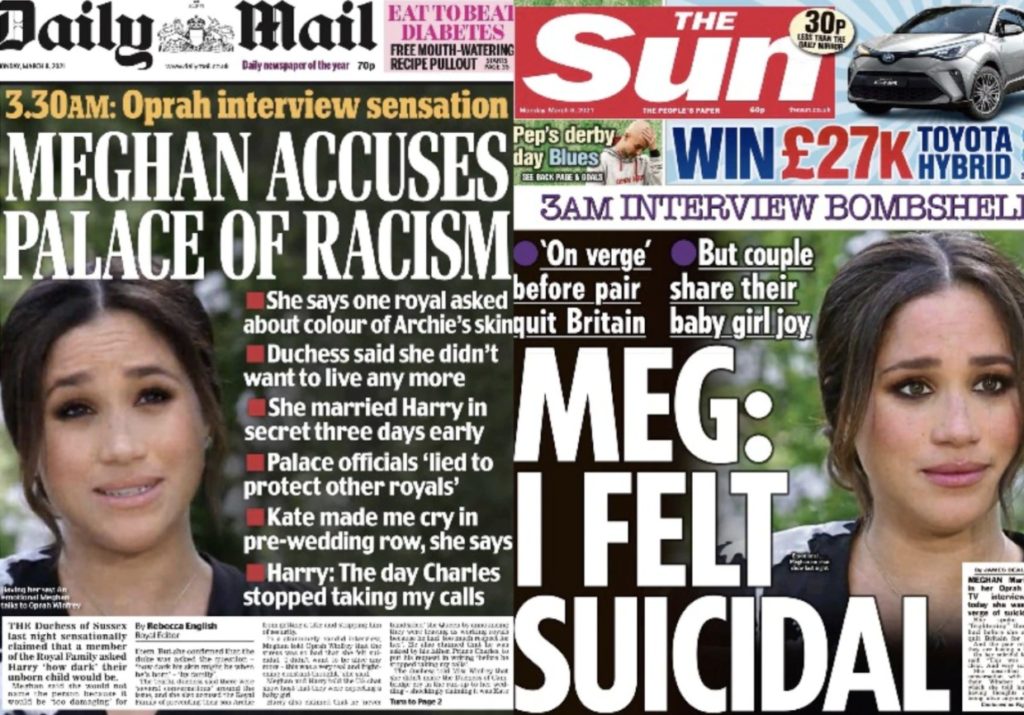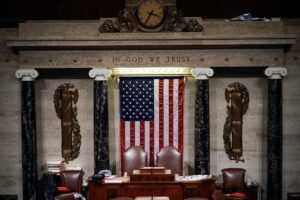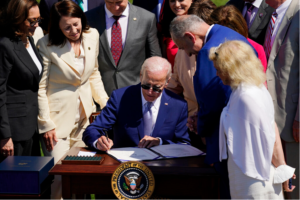
What started as a fairy tale wedding in Windsor Castle has turned into bigotry and racism, leading to media turmoil in an already divided Britain.
Adorned in a white Givenchy gown, a glowing Meghan Markle walked down St. George’s Chapel for her wedding to Prince Harry, seemingly unaware of the palpable elephant in the room: she was a person of color and an American, marrying into an institution with deep roots of colonialism and imperialism. Two years later, the Sussexes’ dramatic split from the Royal Family has halted any further ignorance towards the ugly truth behind the centuries long epidemic that has quietly and continuously plagued Britain: racism.
The Sussexes’ bombshell interview, with American television personality Oprah Winfrey, led to allegations that a member of the Royal Family was concerned about “how dark” their son Archie’s skin would be. Meghan also suggested that Archie was denied a prince title and security due to his mixed-race background.
Given that a majority of the Commonwealth is made up of people of color, Meghan’s entry into the Royal Family ushered in a new sense of hope for change and representation within the monarchy for the country.
Meghan is a mixed race divorcee who wasn’t born into privilege. As an educated actress who had already established a career, she is an “outsider,” very different from other members of the Royal Family. She is someone who actually represented ordinary people, unlike any other individual who was born or married into the Institution. Yet, her sense of independence and modernity was met with negative press that was influenced by sexism and bigotry.
The unfair treatment of Meghan by the British press and the Royal Family revealed in the interview is not shocking, and shed light on the bigger issue of bigotry within the monarchy that has stemmed from a history of deep racial intolerance.
“The royal family is an institution rooted in colonials, white supremacy and racism. The legacy is right there,” remarked Dr. Shola Mos-Shogbamimu during a quarrel with television personality Piers Morgan, on “Good Morning Britain.” “So you’re now surprised that a comment would have been made by several members of the royal family about how dark Archie’s skin is.”
The lack of accountability for the racial damage the monarchy has caused allows current members of the Royal Family to continue nourishing their racist mentality, including instances of discriminatory comments made during public engagements.
In 2002, Prince Philip asked indiginous Aboriginal Australians if they were “still throwing spears.” In 1986, he told British students studying in China that they would become “slitty-eyed” if they remained there for too long. When visiting Kenya in 1984, after receiving a small gift from a local Kenyan woman, he asked, “You are a woman, aren’t you?”
In 2017, Prince Charles and his wife Camilla were filmed laughing while skilled traditional indigineous Inuit throat singers performed for them in Canada.
Charles and Camilla disrespectfully laugh during a traditional Inuit throat singing performance in Canada. Photo Courtesy of Yahoo Lifestyle.
The Royal Family also has connections to Nazism. Prince Philip’s sisters all married Nazis. The Queen’s uncle and former King of Britain, Edward VIII, and his wife, Wallis Simpson, were friends of Adolf Hitler’s.
While the Royal Family’s comments and immature behavior are often dismissed as gaffes, they amplify concerns over the Family’s failure to ameliorate its racist mentality. The current culture war between Britons over race is symptomatic of a deeply racist mind adorned by the monarchy.
Meghan’s poor treatment, both by the Royal Family and the press, along with the Family’s racist proclivity, come from the longstanding lack of accountability towards the monarchy’s racist roots. The monarchy’s history is immersed in xenophobia, discrimination and white supremacy. It is no surprise that a woman of color, like Meghan, was left unprotected. The Institution was built to exploit, not protect, women like her.
Understanding how racism is woven in the Institution dates back to Queen Elizabeth I, a distant ancestor of the current Queen, who approved of the capture and enslavement of Africans by John Hawkins, establishing the British slave trade in the 16th century.
The monarchy has a deep history of colonial power and had stolen territories in North America, Asia, Oceania, and Africa. After the abolishment of slavery, its racist methods of indentured servitude, also known as “a new form of slavery,” continued. Now, Britain is responsible for over sixty independence days.
Countries controlled by Britain’s colonial powers suffered from poverty, malnutrition, diseases, forced servitude, economic exploitation, systemic racial inferiority, and later, political disadvantages. Currently, developing countries lack resources due to the experiences they endured when tasked with the burden of building a nation following the atrocities caused by colonialism. Many developing countries would be thriving with their natural treasures and goods today had they not been looted by the monarchy and British government. Much of Britain and the monarchy’s wealth stems from stolen goods from its colonized territories, including the monarchy’s crown jewels. Many of these stolen artifacts remain in England today, in various museums.
The Koh-i-Noor diamond, sitting in the center of the Queen’s consort crown, made its way through Afghanistan, Iran, and India, from where the British stole the diamond. Photo Courtesy of The Guardian.
Independence for several nations from Britain was an uphill and traumatizing experience, largely due to the ignorance shown by the UK and the monarchy.
The partition of India was a prime example of the racial ignorance that the monarchy exemplified during its colonialist period, where the borders for India and Pakistan were drawn by a British white lawyer, Cyril Radcliffe, who had never visited India. The shortened independence of India by Lord Mountbatten, a member of the Royal Family and the Brit in charge of India’s independence, led to what has been called the largest and most dangerous forced migration in history. Millions of families endured a painful, deadly separation at the hands of the monarchy and the consequences of India’s violent divide continue to be felt through the tensions between India and Pakistan today.
With such a vast history of imperialism, it is not a new revelation that even after colonized territories gained independence, Britain’s bigotry and xenophobic tendancies persist. Prince Harry noted that the attacks on his wife held a sense of “colonial undertones.” Such undertones never ended with colonialism, but rather persevered in Britain and the monarchy during the decades after. Without any accountability, this eventually became the cause for Meghan Markle to leave the Royal Family.
Ignorance by the monarchy towards the struggles of minorities continued to transpire in the 60s and 70s. An era of political demonstrations took place after individuals of African, Asian, and Carribean descent were met with racial injustice and discrimination, even though they had been encouraged by the British government to migrate to the UK in the 50s.
Forceful virginity checks on female immigrants, the expulsion of minorities from London, and racist laws designed to exclude Black and Asian populations in the Commonwealth, namely the 1981 British Nationality Act, are a few reasons for these demonstrations.
Minorities were forced to find multifarious ways to resist this blatant discrimination including forming allies with each other. They organized political demonstrations including the Grunwick Strike in 1976, the Southall Asian Youth Movement in the late 70s, the Brixton Riots in 1981, and the Black People’s Day of Action in 1981 in London.
Different ethnic groups, including Pakistani and Afro-Carribean individuals joined forces to protest racial intolerance in the 1970s. Photo Courtesy of BBC.
The parallels between how the monarchy has handled the struggles of Britons of color and Meghan Markle’s are uncanny. In both circumstances, the Royal Family and its institution have continued to nourish their ignorance and lack of support by behaving as if racial injustice did not exist.
However, racism is very much alive in Britain. It has just been ignored for decades. The conversation of racism in Britain, especially within the monarchy, has just begun at a national scale as a result of the Black Lives Matter Movement and Meghan Markle’s exit out of the Royal Family.
The story of the very first half-Black Duchess is tragic, but not surprising. The underlying bigotry in the monarchy is interlaced into its structure. Racism has allowed the monarchy to continue living. The outdated beliefs and structure of the monarchy would’ve been abolished decades ago had it not been for colonialist and white supremacist beliefs.
This romanticism of European culture has allowed racism and xenophobia to be swept under the rug, especially by the Royal Family, who have refused to acknowledge their part in slavery and colonialism. The Royal Family isn’t automatically “not racist,” just by saying it, as Prince William did. They must be actively anti-racist, which is not the case.
The Royal Family’s lack of acknowledgement towards current racial movements suggests that the racist undertones of the family are still living and breathing. The Institution would not be alive right now if it were not for their colonialist theft.
The monarchy was built upon institutional and systemic racism. White supremacy is embedded within “The Firm,” and it’s time that this outdated system is held accountable for their colonial and racist past.



